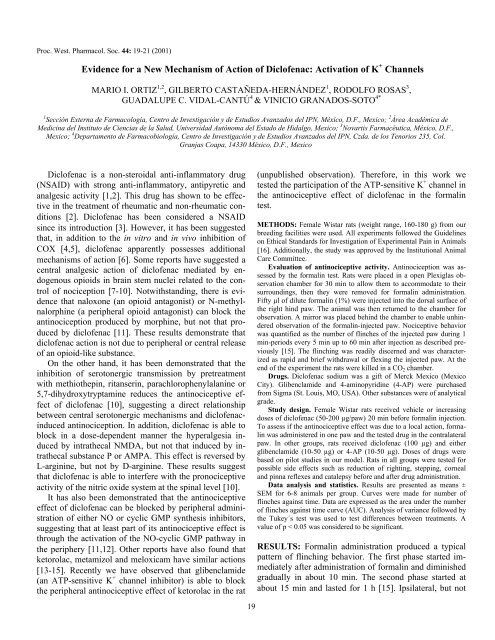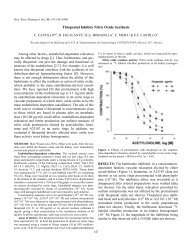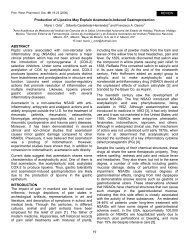Evidence for a New Mechanism of Action of Diclofenac: Activation of ...
Evidence for a New Mechanism of Action of Diclofenac: Activation of ...
Evidence for a New Mechanism of Action of Diclofenac: Activation of ...
Create successful ePaper yourself
Turn your PDF publications into a flip-book with our unique Google optimized e-Paper software.
Proc. West. Pharmacol. Soc. 44: 19-21 (2001)<br />
<strong>Evidence</strong> <strong>for</strong> a <strong>New</strong> <strong>Mechanism</strong> <strong>of</strong> <strong>Action</strong> <strong>of</strong> Dicl<strong>of</strong>enac: <strong>Activation</strong> <strong>of</strong> K + Channels<br />
MARIO I. ORTIZ 1,2 , GILBERTO CASTAÑEDA-HERNÁNDEZ 1 , RODOLFO ROSAS 3 ,<br />
GUADALUPE C. VIDAL-CANTÚ 4 & VINICIO GRANADOS-SOTO 4*<br />
1 Sección Externa de Farmacología, Centro de Investigación y de Estudios Avanzados del IPN, México, D.F., Mexico; 2 Área Académica de<br />
Medicina del Instituto de Ciencias de la Salud, Universidad Autónoma del Estado de Hidalgo, Mexico; 3 Novartis Farmacéutica, México, D.F.,<br />
Mexico; 4 Departamento de Farmacobiología, Centro de Investigación y de Estudios Avanzados del IPN, Czda. de los Tenorios 235, Col.<br />
Granjas Coapa, 14330 México, D.F., Mexico<br />
Dicl<strong>of</strong>enac is a non-steroidal anti-inflammatory drug<br />
(NSAID) with strong anti-inflammatory, antipyretic and<br />
analgesic activity [1,2]. This drug has shown to be effective<br />
in the treatment <strong>of</strong> rheumatic and non-rheumatic conditions<br />
[2]. Dicl<strong>of</strong>enac has been considered a NSAID<br />
since its introduction [3]. However, it has been suggested<br />
that, in addition to the in vitro and in vivo inhibition <strong>of</strong><br />
COX [4,5], dicl<strong>of</strong>enac apparently possesses additional<br />
mechanisms <strong>of</strong> action [6]. Some reports have suggested a<br />
central analgesic action <strong>of</strong> dicl<strong>of</strong>enac mediated by endogenous<br />
opioids in brain stem nuclei related to the control<br />
<strong>of</strong> nociception [7-10]. Notwithstanding, there is evidence<br />
that naloxone (an opioid antagonist) or N-methylnalorphine<br />
(a peripheral opioid antagonist) can block the<br />
antinociception produced by morphine, but not that produced<br />
by dicl<strong>of</strong>enac [11]. These results demonstrate that<br />
dicl<strong>of</strong>enac action is not due to peripheral or central release<br />
<strong>of</strong> an opioid-like substance.<br />
On the other hand, it has been demonstrated that the<br />
inhibition <strong>of</strong> serotonergic transmission by pretreatment<br />
with methiothepin, ritanserin, parachlorophenylalanine or<br />
5,7-dihydroxytryptamine reduces the antinociceptive effect<br />
<strong>of</strong> dicl<strong>of</strong>enac [10], suggesting a direct relationship<br />
between central serotonergic mechanisms and dicl<strong>of</strong>enacinduced<br />
antinociception. In addition, dicl<strong>of</strong>enac is able to<br />
block in a dose-dependent manner the hyperalgesia induced<br />
by intrathecal NMDA, but not that induced by intrathecal<br />
substance P or AMPA. This effect is reversed by<br />
L-arginine, but not by D-arginine. These results suggest<br />
that dicl<strong>of</strong>enac is able to interfere with the pronociceptive<br />
activity <strong>of</strong> the nitric oxide system at the spinal level [10].<br />
It has also been demonstrated that the antinociceptive<br />
effect <strong>of</strong> dicl<strong>of</strong>enac can be blocked by peripheral administration<br />
<strong>of</strong> either NO or cyclic GMP synthesis inhibitors,<br />
suggesting that at least part <strong>of</strong> its antinociceptive effect is<br />
through the activation <strong>of</strong> the NO-cyclic GMP pathway in<br />
the periphery [11,12]. Other reports have also found that<br />
ketorolac, metamizol and meloxicam have similar actions<br />
[13-15]. Recently we have observed that glibenclamide<br />
(an ATP-sensitive K + channel inhibitor) is able to block<br />
the peripheral antinociceptive effect <strong>of</strong> ketorolac in the rat<br />
(unpublished observation). There<strong>for</strong>e, in this work we<br />
tested the participation <strong>of</strong> the ATP-sensitive K + channel in<br />
the antinociceptive effect <strong>of</strong> dicl<strong>of</strong>enac in the <strong>for</strong>malin<br />
test.<br />
METHODS: Female Wistar rats (weight range, 160-180 g) from our<br />
breeding facilities were used. All experiments followed the Guidelines<br />
on Ethical Standards <strong>for</strong> Investigation <strong>of</strong> Experimental Pain in Animals<br />
[16]. Additionally, the study was approved by the Institutional Animal<br />
Care Committee.<br />
Evaluation <strong>of</strong> antinociceptive activity. Antinociception was assessed<br />
by the <strong>for</strong>malin test. Rats were placed in a open Plexiglas observation<br />
chamber <strong>for</strong> 30 min to allow them to accommodate to their<br />
surroundings, then they were removed <strong>for</strong> <strong>for</strong>malin administration.<br />
Fifty µl <strong>of</strong> dilute <strong>for</strong>malin (1%) were injected into the dorsal surface <strong>of</strong><br />
the right hind paw. The animal was then returned to the chamber <strong>for</strong><br />
observation. A mirror was placed behind the chamber to enable unhindered<br />
observation <strong>of</strong> the <strong>for</strong>malin-injected paw. Nociceptive behavior<br />
was quantified as the number <strong>of</strong> flinches <strong>of</strong> the injected paw during 1<br />
min-periods every 5 min up to 60 min after injection as described previously<br />
[15]. The flinching was readily discerned and was characterized<br />
as rapid and brief withdrawal or flexing the injected paw. At the<br />
end <strong>of</strong> the experiment the rats were killed in a CO 2 chamber.<br />
Drugs. Dicl<strong>of</strong>enac sodium was a gift <strong>of</strong> Merck Mexico (Mexico<br />
City). Glibenclamide and 4-aminopyridine (4-AP) were purchased<br />
from Sigma (St. Louis, MO, USA). Other substances were <strong>of</strong> analytical<br />
grade.<br />
Study design. Female Wistar rats received vehicle or increasing<br />
doses <strong>of</strong> dicl<strong>of</strong>enac (50-200 µg/paw) 20 min be<strong>for</strong>e <strong>for</strong>malin injection.<br />
To assess if the antinociceptive effect was due to a local action, <strong>for</strong>malin<br />
was administered in one paw and the tested drug in the contralateral<br />
paw. In other groups, rats received dicl<strong>of</strong>enac (100 µg) and either<br />
glibenclamide (10-50 µg) or 4-AP (10-50 µg). Doses <strong>of</strong> drugs were<br />
based on pilot studies in our model. Rats in all groups were tested <strong>for</strong><br />
possible side effects such as reduction <strong>of</strong> righting, stepping, corneal<br />
and pinna reflexes and catalepsy be<strong>for</strong>e and after drug administration.<br />
Data analysis and statistics. Results are presented as means ±<br />
SEM <strong>for</strong> 6-8 animals per group. Curves were made <strong>for</strong> number <strong>of</strong><br />
flinches against time. Data are expressed as the area under the number<br />
<strong>of</strong> flinches against time curve (AUC). Analysis <strong>of</strong> variance followed by<br />
the Tukey´s test was used to test differences between treatments. A<br />
value <strong>of</strong> p < 0.05 was considered to be significant.<br />
RESULTS: Formalin administration produced a typical<br />
pattern <strong>of</strong> flinching behavior. The first phase started immediately<br />
after administration <strong>of</strong> <strong>for</strong>malin and diminished<br />
gradually in about 10 min. The second phase started at<br />
about 15 min and lasted <strong>for</strong> 1 h [15]. Ipsilateral, but not<br />
19
contralateral, local administration <strong>of</strong> dicl<strong>of</strong>enac produced<br />
a dose-dependent reduction in the flinching behavior otherwise<br />
observed after <strong>for</strong>malin injection (Fig. 1). Dicl<strong>of</strong>enac<br />
significantly reduced the number <strong>of</strong> flinches during<br />
phase two (p < 0.05), but not during phase one. No<br />
side effects were observed in either group, control or<br />
treated.<br />
It was observed that glibenclamide, an ATP-sensitive<br />
K + channel blocker, was able to diminish dicl<strong>of</strong>enac-<br />
20<br />
induced antinociception. The fact that glibenclamide specifically<br />
blocks ATP-sensitive K + channels, with no effect<br />
on Ca 2+ - or voltage-dependent K + channels [18-20] suggests<br />
that dicl<strong>of</strong>enac produced, at least part <strong>of</strong>, its antinociceptive<br />
effect through the opening <strong>of</strong> the ATP-sensitive<br />
K + channel. To our knowledge, this is the first report on<br />
the participation <strong>of</strong> the ATP-sensitive K + channel in the<br />
antinociceptive activity <strong>of</strong> a NSAID. However, 4-AP also<br />
blocked dicl<strong>of</strong>enac-induced antinociception. As 4-AP is<br />
considered as a voltage-dependent K + channel inhibitor<br />
[21], our results suggest that, beside the ATP-sensitive K +<br />
channels, dicl<strong>of</strong>enac also opens the voltage-dependent K +<br />
channel.<br />
Figure 1. Local antinociceptive effect <strong>of</strong> dicl<strong>of</strong>enac during the second<br />
phase <strong>of</strong> the <strong>for</strong>malin test. Rats received intraplantar pretreatment with<br />
saline and dicl<strong>of</strong>enac and then a <strong>for</strong>malin (1%) injection (50 µl). Data<br />
are expressed as the area under the number <strong>of</strong> flinches against time<br />
curve (AUC). Bars are the means ± SEM <strong>of</strong> 6-8 animals. *Significantly<br />
different from saline (p < 0.05), as determined by analysis <strong>of</strong> variance<br />
followed by the Tukey´s test.<br />
Glibenclamide or 4-AP (10-50 µg/paw) did not produce<br />
any effect by themselves. However, either glibenclamide<br />
or 4-AP (ATP-sensitive and voltage-dependent<br />
K + channel inhibitors, respectively), but not vehicle, significantly<br />
blocked dicl<strong>of</strong>enac-induced antinociception<br />
during the second phase <strong>of</strong> the <strong>for</strong>malin test (Fig. 2). In no<br />
group were visible side effects observed.<br />
DISCUSSION: In this study we observed peripheral<br />
antinociception with dicl<strong>of</strong>enac. The peripheral effect <strong>of</strong><br />
dicl<strong>of</strong>enac was due to a local action as the administration<br />
<strong>of</strong> this drug at the contralateral paw was ineffective. It is<br />
well known that dicl<strong>of</strong>enac is a non-selective COX inhibitor<br />
[17]. There<strong>for</strong>e it is likely that its antinociceptive effect<br />
could result from COX inhibition. However, other<br />
actions [11] different from COX inhibition cannot be<br />
ruled out.<br />
Figure 2. Effect <strong>of</strong> glibenclamide (Gli) and 4-aminopirydine (4-AP) on<br />
the antinociceptive activity <strong>of</strong> dicl<strong>of</strong>enac in the <strong>for</strong>malin test. Rats<br />
received intraplantar pretreatment with dicl<strong>of</strong>enac (100 µg) alone or<br />
coadministered with Gli or 4-AP and then a <strong>for</strong>malin (1%) injection<br />
(50 µl). Data are expressed as the area under the number <strong>of</strong> flinches<br />
against time curve (AUC). Bars are the mean ± SEM <strong>of</strong> 6-8 animals. *<br />
Significantly different from vehicle (p < 0.05); # significantly different<br />
from the dicl<strong>of</strong>enac group, as determined by analysis <strong>of</strong> variance followed<br />
by the Tukey´s test.<br />
In summary, dicl<strong>of</strong>enac produced peripheral antinociception<br />
in the <strong>for</strong>malin test in the rat. The antinociceptive<br />
effect <strong>of</strong> dicl<strong>of</strong>enac was antagonized by glibenclamide<br />
and 4-AP. These results strongly suggest that, besides<br />
the inhibitory action on prostaglandin synthesis, the<br />
opening <strong>of</strong> the ATP-sensitive and voltage-dependent K +<br />
channels has an important role in the peripheral antinociception<br />
<strong>of</strong> dicl<strong>of</strong>enac in the <strong>for</strong>malin test.<br />
ACKNOWLEDGEMENTS: M.I. Ortiz is a PROMEP<br />
fellow. Authors greatly appreciate the bibliographic assistance<br />
<strong>of</strong> H. Vázquez.<br />
REFERENCES<br />
1. Menasse R, Hedwell PR, Kraetz J, Pericin C, Riesterer L, Sallmann<br />
A, Ziel R & Jaques R: Scand J Rheumatol (Suppl 22): 5-16 (1978).<br />
2. Todd PA & Sorkin EM: Drugs 35: 244-285 (1988).<br />
3. Krupp PJ, Menasse-Gdinia R, Sallmann A, Wilhelmi G, Ziel R &<br />
Jaques R: Experientia 29: 450-452 (1973).
4. Ku EC, Wasvary JM & Cash WD: Bioch Pharmacol 24: 641-643<br />
(1975).<br />
5. Oliw E, Lundén I & Anggard E: Acta Pharmacol Toxicol 42: 179-<br />
184 (1978).<br />
6. Attal N, Kayser V, Echalier A, Benoist JM & Guilbaud G: Pain 25:<br />
341-348 (1988).<br />
7. Martini A, Bondiolotti GP, Sacerdote P, Peirro L, Picotti GB,<br />
Panerai AE, Restelli L, Zancarrer F & Monza G: J Int Med Res 12:<br />
92-94 (1984).<br />
8. Sacerdote P, Monza G, Mantegazza P & Panerai AE: Pharmacol<br />
Res Commun 17: 679-684 (1985).<br />
9. Vescovi P, Passeri M, Guerra G & Grossi E: Pain Clinic 87: 151-<br />
154 (1986).<br />
10. Björkman R: Acta Anaesthesiol Scand (Suppl. 103) 39: 1-44<br />
(1995).<br />
11. Tonussi CR & Ferreira SH: Eur J Pharmacol 251: 173-179 (1994).<br />
12. López-Muñoz FJ, Castañeda-Hernández G, Torres-López JE, Picazo<br />
YF, Flores-Murrieta FJ & Granados-Soto V: Pharm Sci 2:<br />
189-190 (1996).<br />
13. Granados-Soto V, Flores-Murrieta FJ, Castañeda-Hernández G &<br />
López-Muñoz FJ: Eur J Pharmacol 277: 281-284 (1995).<br />
14. Lorenzetti, B.B., Ferreira, S.H: Inflamm Res 45: 308-311 (1996).<br />
15. Aguirre-Bañuelos P & Granados-Soto V: Eur J Pharmacol 395: 9-<br />
13 (2000).<br />
16. IASP: Pain 16: 109-110 (1983).<br />
17. Vane JR & Botting RM: Scand J Rheumatol (Suppl. 102) 25: 9-21<br />
(1996).<br />
18. Amoroso, S., Schmid-Antomarch, H., Fosset, M & Ladzunky M:<br />
Science 247: 852-854 (1990).<br />
19. Davies NW, Standen NB & Stanfield PR: J Bioenerg Biomembr<br />
23: 509-535 (1991).<br />
20. Edwards G & Weston AH: Annu Rev Pharmacol Toxicol 33: 597-<br />
637 (1993).<br />
21. Cook NS & Quast U: Potassium Channels: Structure, Classification,<br />
Function, and Therapeutic Potential, (ed) NS Cook, Chichester,<br />
Ellis Horwood Limited, (1990), p. 181.<br />
21









